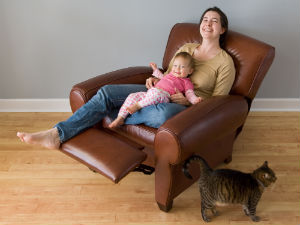Thanks to California law TB 117 from 1975, your comfy recliner better resembles a chemical waste facility than it does a relaxing chair. What do I mean? Well, TB 117 requires the foam in sofas, love seats, recliners, car seats, electronics, and insulation be treated with ultra toxic flame retardants. Although they may prevent your wares from immediately going up in a blaze, they are not without serious consequence to your health.

The Dangers of Flame Retardants
Flame retardants — globally recognized as toxic contaminants — have been associated with reproductive disorders, cancer, immune dysfunction, hormone disruption, suppressed thyroid function, and serious damage to fetal and child brain development. Here are 10 facts you need to know to protect you and your loved ones from these dangerous, pervasive toxins.
1. Your Dust Bunnies Are Toxic
According to Duke University associate professor of environmental chemistry Heather Stapleton, “If you really look at what’s in your dust, particularly for some chemicals, it’s just as concentrated — or more — as what you’d find in sewage sludge.” [1] What she and many other researchers discovered is flame retardants like PBDEs and chlorinated tris escape from the foam and accumulate in dust. Dust bunnies, by their nature, collect greater amounts of these chemicals. The more that around, the greater your exposure. Pets and little ones crawling on the floor may be most susceptible.
2. The 2006 Ban on PBDEs Did Not Make Furniture Safe
Although PBDEs were supposedly banned in 2006, the chemical used to replace them is equally as dangerous. Chemical manufacturers reverted to using chlorinated tris (or TDCPP), a chemical banned from use in children’s pajamas in 1977 because it causes DNA mutations and cancer. Even the newer chemical known as V6 contains tris. Research shows chlorinated tris is more toxic than the pesticide chlorpyrifos, a known neurotoxin. [2] Tris remains as dangerous today as in 1977.
3. Baby Products Are Loaded with Flame Retardants
You know why you’ve never heard of a “Foam tree”? It’s because foam, despite being soft, is not natural, it’s the product of mixing chemicals together. Subsequently, it comes as no surprise that car seats, changing pads, and other foam baby products are loaded with chemicals, including flame retardants. [3] Tris and a new chemical known as V6 (which contains tris) make up about 4.6% of the mass of the foam in baby products. [4] All the same health dangers apply which is why the best way to protect your little ones is to use and expose them to as few foam products as possible.
4. Children Are Most Vulnerable
Tests have shown that children typically have three times as much fire retardants in their blood as their mothers. The reason for this is believed to be the fact that children play on the floor where dust and carpeting collect fire retardants as the previously mentioned dust bunnies. This may explain the ever-increasing number of children suffering from hormonal and metabolic imbalances.
5. Flame Retardants Affect Unborn Babies
Pregnant women need to be especially aware of exposure to flame retardants. Research has shown that PBDEs have no problems crossing the placenta and can transfer harmful effects from mother to fetus. PBDEs have been found in the fetal blood of women exposed to products that have been treated with flame retardants. [5] Observations of children with higher levels of PBDEs in their blood revealed greater incidences of hyperactivity and decreased learning and memory.
6. They Cause Male Infertility
Regular exposure to organophosphate flame retardants alter a man’s hormone levels, leading to poor semen quality and decreased sperm count. [6] Read more
No comments:
Post a Comment